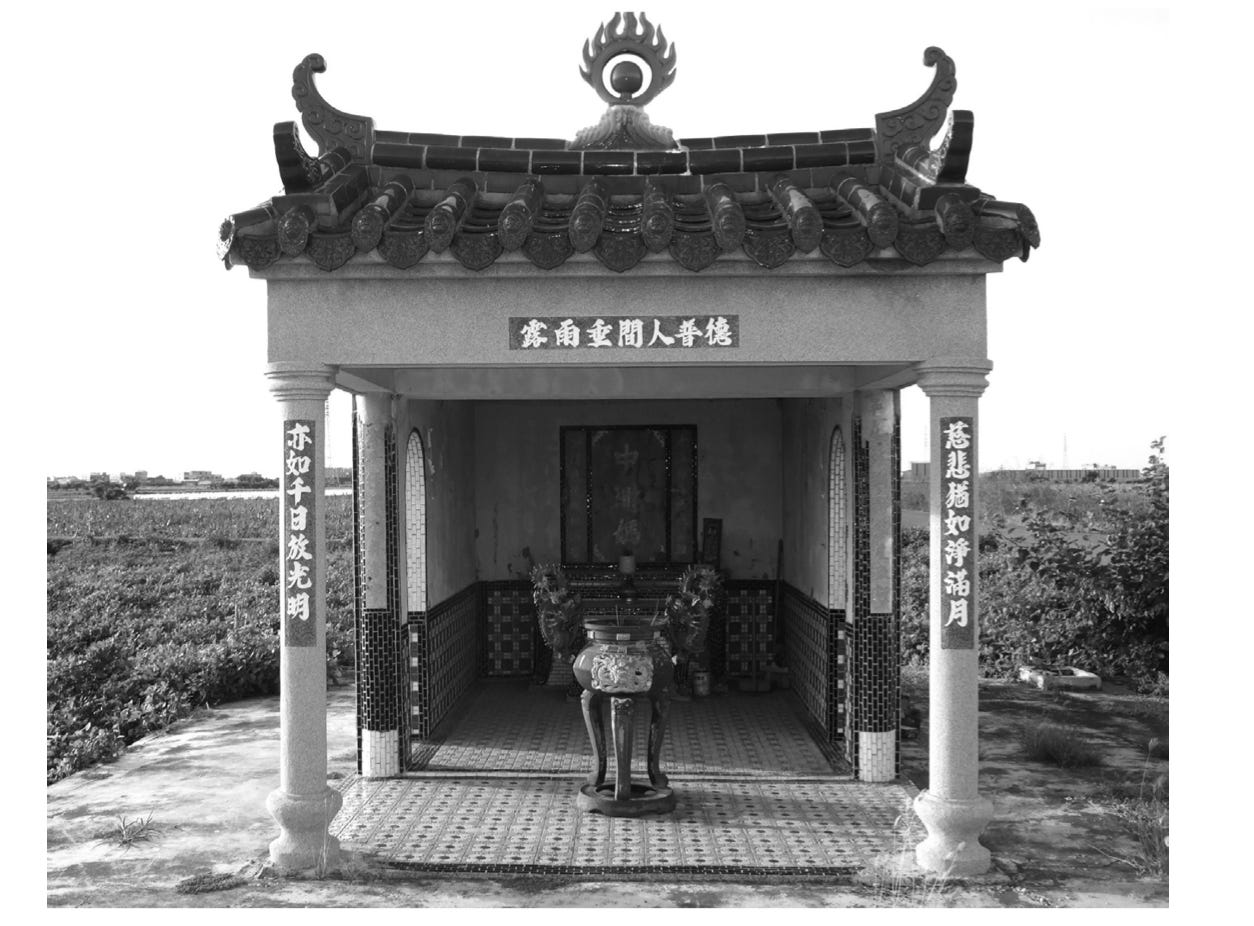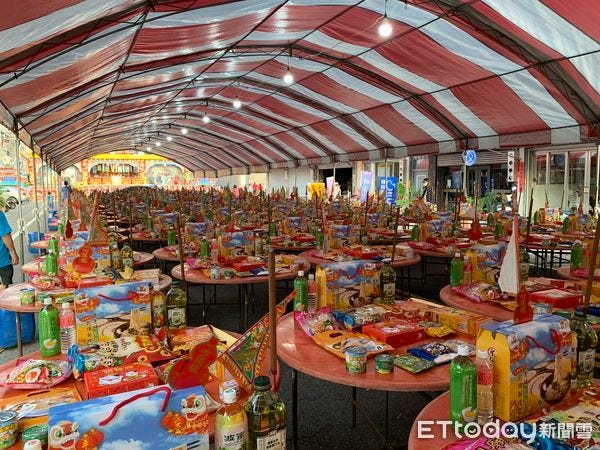Who are the ghosts and what do they want?
On Ghost Month, a popular religious festival in Taiwan. Plus videos of Wolf and Cat Warriors.
Hello dear readers!
It’s Ghost Month in Taiwan, a popular religious festival, and we went down a delightful rabbit hole researching its meaning. But first, an update on the Pelosi visit.
Last we wrote, the People’s Liberation Army was conducting live-fire war games around the Taiwan Strait. Those exercises ended earlier this week, but the Chinese government has vowed to continue regular patrols in the future. The PRC is explicitly indicating a new “status quo” in which it intends to assert a more robust presence here. In the meantime, the Taiwanese military has conducted its own military drills, simulating how it would defend the island.
But the real consequential actions have come in the realm of diplomacy, as Beijing suspended bilateral climate talks with Washington, a real blow to urgently needed joint action between the two largest carbon emitters in the world. Nature reports that academic collaboration between the two countries has not been affected so far, but scientists fear that the escalating geo-political tensions will threaten future joint research projects.
Meanwhile, high-ranking Chinese and Taiwanese diplomats made the rounds on talk shows to defend their governments’ positions. The Chinese ambassador to France, Lu Shaye—“the dominant alpha of wolf warrior diplomats,” according to Politico—went on French television to proclaim that the CCP would use force to “reunify” Taiwan and China. Upon annexation (that’s the term we prefer), it would launch a “re-education campaign” to make the Taiwanese Chinese patriots again. For reference, the Chinese state has used re-education to euphemize its genocidal policies in Xinjiang, where it’s suppressed Uyghur culture, destroyed holy sites, and jailed intellectuals.
The top Taiwanese diplomat in the United States, Hsiao Bi-Khim, who charmingly calls herself a “Cat Warrior,” responded to the current situation with a cat picture.


Like Lu, Hsiao has been invited to speak on all of the major U.S. talk shows. On Face the Nation, she was asked whether Nancy Pelosi’s visit was a provocation. She replied:
I think the word “provocation” has only one place, and that's with China right now. They are the ones provoking regional instability. And what we are going to do is try to ensure that we continue to live under an environment in which the Taiwanese people can freely determine our future.
There’s been so much commentary and we’ve tried our best to process everything. If you’re interested in following the news in real-time, we’ve found William Yang’s Twitter feed and his reporting for Deutsche Welle particularly good resources.
Ghost Month: On Worshipping the Marginal and “Improperly Dead”
In Taiwan, Ghost Month is the time when the gates of the underworld open, letting ghosts out to roam the world of the living.
All around the country you’ll see tables of offerings—temporary altars—that contain fruit, rice, snacks, cooked chicken, and beer. Often there are large cans of fire for burning paper money, with a towel and wash basin next to it. These altars are everywhere, from fancy high-rise buildings to tiny storefronts to construction sites. We’ve seen dentists, nurses, real estate agents, car mechanics, and laborers in hard hats lighting incense sticks and bowing their heads.

The rules for Ghost Month are at once whimsical and creepy:
Don’t borrow a stranger’s umbrella or take an unclaimed one. Spirits reside under them and may follow you into your house.
Likewise, don’t bring your own umbrella into the house.
Don’t point slippers towards your bed. You might be welcoming ghosts into it.
Don’t call them “ghosts.” Refer to them as “good sisters” (好姐妹) or “good brothers” (好兄弟).
Don’t touch the towels or the water basin at the offering table: they’re for the ghosts to wash themselves or to wipe off sweat. (Michelle to Albert: “Ghosts sweat?”)
Don’t refer to yourself by your full name. They may hear it.
On Ghost Day, wear bright colors.
After you eat, don’t look back. They may follow you.
Don’t have a wedding. Ghosts may crash it.
At the offerings table, don’t provide certain kinds of fruit (pears, lychees, bananas).
Avoid whistling. Spirits are drawn to it.
Don’t stand under a tree or bus stop.
Don’t go swimming or stand in the water, as ghosts live there and may carry you off.
There are dozens more rules. These are just a taste.
*
By now you’re probably wondering: Who are these ghosts? What do they want?
We had the same questions. We could have asked the good brothers and sisters directly, but we were too cowardly. In this case oral history is not our preferred methodology. Instead, we immersed ourselves in some of the fascinating anthropological literature on ghost festivals, and learned that there are brave people—spirit mediums, local Buddhist or Daoist priests—who opt to make contact with ghosts. (More on this below!)
The key to understanding ghosts is that they were people who died in a nonconforming, shameful, idiosyncratic, or indecent way: by accident, suicide, disaster, in humiliating poverty, in a place without kin or friends. Anthropologist Robert Weller calls them “the improperly dead.”1 Fires, coal mine collapses, drownings, even deaths of scholars on the way to take the provincial or imperial exam—these all can make ghosts. Deaths where bones are irretrievable, such as deep lakes or far away lands, can too. Ghosts are the “marginal dead,” Weller writes, “with no descendants to worship them, indigents who cannot be identified.”
Their default descriptor is “hungry,” which tells us quite a bit. Deprived of basic sustenance, ghosts need human attention. They want to be fed and have nobody to feed them. But, as Weller writes, they’re not to be mistaken for “bandit gangs or beggar guilds,” because they’re asocial and without attachment. They’re “simply isolated individuals,” lost among the living.
It’s easy to confuse ghosts with the two other categories of spirits, ancestors and gods. The rituals appear similar: you make offerings, burn paper money, light incense, and bow your head in prayer. But the relationships and materials tend to differ. For instance, ghosts receive silver incense paper; ancestors and gods receive gold. As anthropologist Wei-Ping Lin observes, the goal with ghosts is to placate the good brothers and sisters in the hopes that they'll go away.2 With the ancestors and gods, in contrast, your aim is not to truncate your relationship but to continue it. The rituals also differ: ancestors are worshipped inside homes, gods in temples. Ghosts are “worshipped” outside.
*
Who are the ghosts roaming Taiwan today? Lin, who did her fieldwork in Wannian, a village north of Tainan, describes a mother and daughter who died in a thatched hut that caught fire. Nearby workers described “footsteps of the mother and daughter walking back and forth through the field.” They heard occasional screaming as well. Villagers raised money to build a three-walled building for the mother and daughter and a shrine for offerings, so they’d have a place to rest and eat. But this failed to satisfy the ghosts. Villagers tell stories of strange occurrences near the place of death: plows suddenly breaking down, a mysterious cold wind striking, a person falling ill immediately after.

But ghosts don’t exist merely to be feared. They’re also manipulated—and, apparently, consulted for lottery numbers. Lin attended several events where “chair holders”—the equivalent of a spirit medium—make contact with the ghosts. When they start to shake violently, it’s a sign that the ghost will come. She continues:
The villagers told me that when a ghost approaches, people feel a chill descend upon them, and sometimes a fishy odor (in contrast to the warm and pleasant fragrance when deities come). Ghosts can be quite unpredictable during a possession. For instance, it is said that once a ghost refused to leave the bodies of the chair holders after the consultation. Therefore, this kind of event always involves some risk, showing the extraordinary courage of the chair holders in allowing ghosts to possess their bodies.
The consultation involves some negotiating: if the lottery numbers turn out to be winners, how many offerings should the villagers prepare in recompense?
Confusingly, these lines can also get blurred. Ghosts can become gods; ghosts can also become part of your ancestry. Consider a “spirit marriage: often these involve a woman who dies in childhood and haunts her family. The family might persuade, bribe, or deceive a man to marry her ghost. Once married, she has her name entered into the ancestral tablet, thereby gaining a place to reside. The man is also free to marry another person. (Don’t ask us how this works, we’re still investigating.)
*
In Taiwan, every government—the Qing dynasty, the Japanese colonial regime, and the Kuomintang (KMT)—detested the ghost festival, resenting the power it held over people. These successive states, recognizing that the ritual expressed an ideological critique of the state’s inability to care for the poor and marginal, struggled—and failed—to banish ghost rituals, deeming them by turns antirational, superstitious, exploitative of people’s incomes, or anti-modern.
In the Qing period, as Weller writes, local elites would donate food to temples for Ghost Month. Actual beggars and other vulnerable people would thus emerge from invisibility. Put more simply, hungry people became public. You can see why the state felt threatened: the large numbers of impoverished people exposed the extent of its failures.
The state also feared mass revolt. For decades from 1890 to 1930, the festival could become quite violent. The backstory here is one of capitalism, migration from China, and encroachment on indigenous land. Migrant workers from southern China came to work in Taiwan’s booming camphor industry, competing for jobs in forests on mountain land where indigenous groups lived. The work was dangerous, in part because they had to fight those indigenous groups who sought to protect their land and trees from ravage.
In a sort of Squid-Game-Meets-Lord-of-the-Flies mashup, marginalized people fought for the food in a ritual called “robbing the lonely ghosts.” Weller notes that organizers placed “immense quantities of food” at the top of an elevated altar that reached up to sixty feet, made of “bamboo poles” structured like “cones that stretched from five to ten feet in diameter at the base.” In certain instances, as many as forty thousand beggars, workers, and other competitors would gather. After the ceremony, they’d climb to the top of the pole, jousting for the food. The “whole scene was one mass of arms and legs and tongues,” wrote a Presbyterian missionary in 1895. “Screaming, cursing, howling, like demons of the pit, they all joined in the onset. It was a very bedlam, and the wildness of the scene was enhanced by the irregular explosion of firecrackers and the death-groan of some one worsted in the fray.”
Roughly a generation later, a Japanese anthropologist in the 1920s made a similar observation:
The robbing of the lonely ghosts took place at 6:30 p.m., and the start was signaled by a puff of smoke, when everyone began their enthusiastic plunder. The sounds of assault and murder pierced heaven. . . . Hordes of people began to climb the lonely ghost platform, each anxious to stay ahead of the others. . . . The lonely ghost platform was covered with people, each enthusiastically stealing the offerings, pushing and screaming, and robbing each other. They say that with the ghosts’ protection they will not be hurt, but in fact large numbers are always hurt and killed.
If the ghosts were so dangerous, why weren’t people afraid to steal their food?
There’s a simple answer to this: they were! That’s why you had to be quick and athletic, scaling the altar with alacrity. But we wonder—and this is pure speculation—whether the people identified with the hungry ghosts so much that the ghosts stopped seeming dangerous or foreign. Put another way, the hungry ghosts appeared exactly as secularists would see them: desperate, lonely figures created in our human image. The ritual itself consolidated that identification. People self-consciously took on the guise of ghosts, demanding to be fed.
The Qing state was weak and unable to assert control; the Japanese state, much more centralized and powerful, managed to send troops and repress the melees. But it wasn’t able to ban the rituals outright. Instead, by the 1930s, the rituals had transformed into explicit athletic competitions, a tradition that continues today. At the Hengchun “Ghost Grappling Festival” (中元搶孤), teams compete to climb up poles covered with tar. This year, the winning team took home 350,000 NTD (roughly 10,000 USD).
Like the Japanese colonial government, the KMT was unable to control the religious festivals. They had perhaps learned their lesson in China; as historian Rebecca Nedostup writes, the early KMT regime issued an outright ban in 1934, "making the Ghost Festival the only festival universally targeted by name."3 By the time the KMT occupied Taiwan, its goals had also changed: it wanted to distinguish itself from the PRC by claiming that it promoted freedom of religion. In the 1950s it permitted Ghost Month but sought to change the symbolic meaning of the rituals, depicting them as proof of economic prosperity and the rising wealth of society. More sweepingly, as Weller has argued, the past 150 years or so have seen a transformation of ghosts from considered dangerous to being considered pitiful.
More recently, the government has promoted Ghost Month festivals as an essential part of Taiwanese popular religious culture, as well as an entertaining attraction for tourists. Today, one of the most vibrant festivals can be found in Huwei, Yunlin, where Alan Yang’s gorgeous film Tigertail partly takes place. (Huwei is the hometown of Yang’s parents.) Huwei’s annual Ghost Month festival boasts thousands of tables of ritual objects, ice sculptures, and dancing robots. (You read that right: ice sculptures in the heat and humidity of Taiwan in August.)

In Keelung, a port city north of Taipei, people today still observe the tradition of burning “water lanterns” for those who have drowned at sea. The lonely ghosts are invited to eat on land, and then the burning boats lead them back out into the water. The emphasis is on pity for the poor and the drowned. As historian Evan Dawley observes, for more than 150 years the Ghost Festival “strengthened a sense of community” in the city.4
Meanwhile, just last night, tragic news came out of Taoyuan. About twenty people were paying their respects to ghosts, standing in the water with hands joined and pushing rafts of offerings into the ocean, when a sudden tide dragged three people to their deaths. Here in the Kuo-Wu household—admittedly prone to superstitious beliefs—these deaths were quite disturbing, a reminder that, however sanitized contemporary rituals are, an element of danger persists and endures.
Ghost Month is often depicted as a quirky custom, a holdover from the past. But we’ve thought a lot while writing this piece about how ghosts reflect our relationship to those who live on the margins of society. Fundamentally, these rituals show respect to those whom we’ve abandoned. How do we fold them into an ethic of care, into a structure of compassionate? Ghost Month points to an answer. Feed them. Worship them. Acknowledge their pain. Give them humane ways to wash themselves. Call them brothers and sisters.
These rituals show the hope and limits of human aspiration, revealing our empathy as well as our hypocrisy. We provide food for these abandoned others but don’t welcome them into our homes. We call them brothers and sisters but hope they go away. We pay our respects for one month of the year but banish them for the rest.
Book Club: Lisa Hsiao Chen’s Activities of Daily Living
We’re looking forward to our book club about Lisa Hsiao Chen’s wonderful book Activities of Daily Living on Friday, August 26th, 4 PM PDT/7 PM EST. Can’t wait! Please email us at broadandampleroad@gmail.com (or reply to this email) if you want to join.
See Robert P. Weller, “Bandits, Beggars, and Ghosts: The Failure of State Control over Religious Interpretation in Taiwan,” American Ethnologist 12, no. 1 (1985).
See Wei-Ping Lin, “Mother Ghost Seeks a Human Son-in-Law: Ghost Shrines in Taiwan,” Magic, Ritual, and Witchcraft 13, no. 2 (2018), 190-211.
Rebecca Nedostup, Superstitious Regimes: Religion and the Politics of Chinese Modernity (Harvard University Press, 2010), 244-251.
Evan Dawley, Becoming Taiwanese: Ethnogenesis in a Colonial City, 1880s to 1950s (Harvard University Press, 2019), 190.




